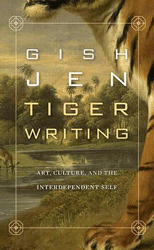By LaiYee Leong
It is no accident that Gish Jen has titled this work Tiger Writing, echoing Amy Chua’s The Battle Hymn of the Tiger Mother. In that book, Chua suggests her Chinese background explains her approach to child rearing, which is notably tougher than the practices of non-immigrant Americans. Likewise, novelist Jen seeks to articulate how her Asian heritage has shaped her storytelling in a manner distinct from that of white American authors. Eclectically mixing literary analysis and cognitive studies as well as family history, Jen muses on the impact of cultural conceptions of the self on the literary narrative. But just as Chua’s parenting ambitions ironically capture the American spirit of do-what-it-takes, so Jen’s contemplation ultimately leads her to reflect that her writing is quintessentially American. Tiger Writing is about a writer who successfully builds “a very real bridge between East and West” with “the stuff of fiction.”
This slim volume collects three public lectures that Jen delivered at Harvard in 2011. Tasked to provide an intellectual autobiography, Jen examined the “special way in which my cultural background was profoundly at odds with the literary culture I negotiated every day.” Jen has authored numerous essays and books, the most recent being World and Town (2011). Among the themes her stories repeatedly explore are ethnic identity and what it means to be American. In Tiger Writing, Jen ponders these subjects in a deeply personal and candid way. One does not need to know her critically acclaimed works to appreciate this book.
Jen begins by sharing the memoir that her Chinese immigrant father wrote. She points out some striking aspects, including its concern with ancient genealogy and an emphasis on the architecture of the family’s multi-generational home. As Jen sees it, her father’s self-narrative is instructive for its focus on context and others over the individual. It motivates her to consider how the self is rendered in separate cultural traditions. Finding the answer in social science research, Jen suggests ethnic Asians and Western Europeans filter their experiences differently. She reports that, whether in observing, remembering, or retelling, Asians tend to focus on situational dynamics and the perspective of others. Westerners attend more to an autonomous, activist self. Building on this apparent divergence, Jen posits that Eastern art reflects and reifies the “interdependent self” while Western art favors the “independent self.” According to her, it is the “troublemaking” independent self that animates the Western or American novel, for its narrative revolves around and celebrates the individual.
Jen then returns to the autobiographical, moving away from the cliff of ethnic determinism to a more nuanced approach. She suggests the culturally-shaped idea of self can join with new influences to become something unique. As a young reader, Jen giddily ingested the books of Western literature and unconsciously “adapted for my program an existing cultural template” different from the one at home. The genesis of Gish Jen the novelist is traced to her practicing “creative selective assimilation.” Dissecting her own work, Jen determines – with genuine surprise – an “unusual degree of context-oriented questions” in her writing:
“Questions that – because I asked them of the American context – have, despite their Chinese origin, ironically rendered me a distinctly American writer.”
In fusing two perspectives, Jen concludes she has an original contribution to make to the culture of the literary narrative about which she earlier expresses uneasiness.
Tiger Writing is the self-portrait of a writer working through “something in my bones I had not quite managed to articulate.” Jen invites the reader to wander through her personal ruminations much as one might meander through a house with many doors (to use a leitmotif). But like a family home, some rooms are more interesting and revealing than others. The most compelling parts are the intimate tales: the affectionate discussion of the father’s life story and the account of Jen’s experiences as a budding writer. The rapid-fire allusions to favored authors, however, are daunting for the non-specialist and do not illuminate. As for the references to behavioral studies, they appear selectively chosen. Moreover, is it really a mere “hopskip” from social science findings to art-making? Though highly illustrative, the leap seems contrived.
Peripheral flaws notwithstanding, Tiger Writing is thought-provoking without being convoluted, an easy trap for the self-conscious act of writing about writing. Jen brings a light yet sure touch to the weighty subjects of ethnicity, culture, and art. The gentle humor and wit throughout make this an accessible book. It is also an important work in staking a claim for what it means to be an American writer.
LaiYee Leong is an associate research fellow at the John G. Tower Center for Political Studies at Southern Methodist University. Southern Methodist is home to the Gamma of Texas chapter of Phi Beta Kappa.




